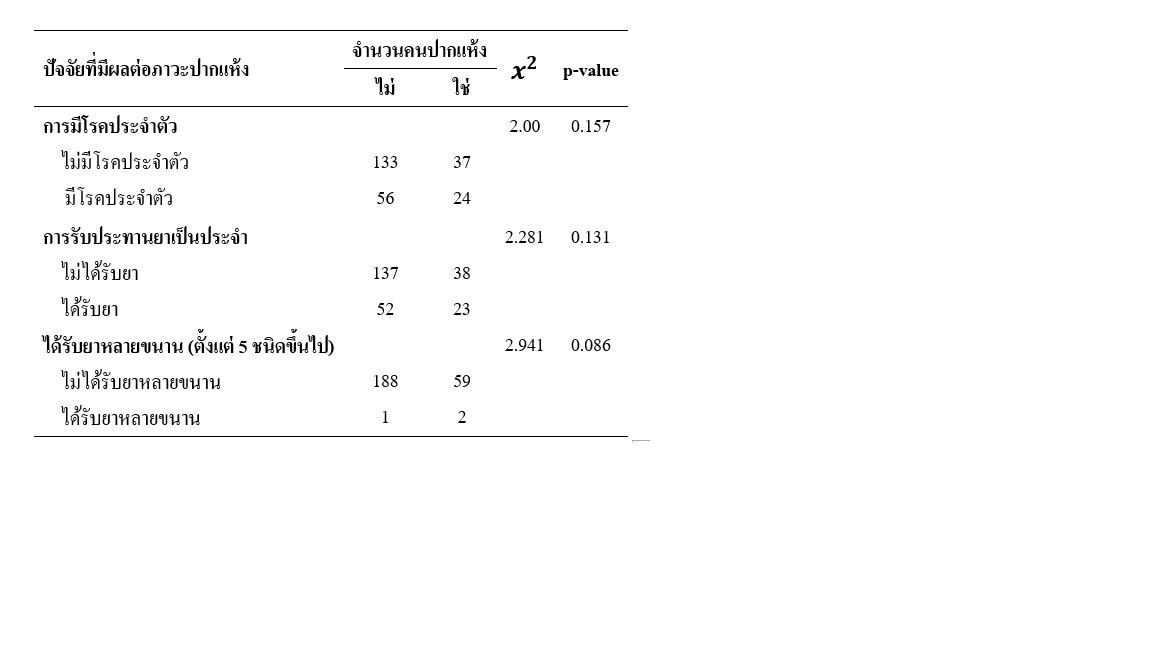ความชุกของภาวะปากแห้งในผู้สูงอายุ อำเภอเมือง จังหวัดร้อยเอ็ด
คำสำคัญ:
ผู้สูงอายุ, ภาวะปากแห้งบทคัดย่อ
ภาวะปากแห้ง (xerostomia) เป็นปัญหาหนึ่งที่พบได้ในผู้สูงอายุซึ่งส่งผลกระทบต่อคุณภาพชีวิตของผู้สูงอายุ การศึกษานี้มีวัตถุประสงค์เพื่อศึกษาความชุกและความสัมพันธ์ของปัจจัยที่เกี่ยวข้องกับภาวะปากแห้งในผู้สูงอายุ อำเภอเมือง จังหวัดร้อยเอ็ด เป็นการศึกษาเชิงพรรณนาแบบภาคตัดขวาง กลุ่มตัวอย่าง 250 คน เก็บข้อมูลโดยการใช้แบบสอบถามวัดระดับความรุนแรงของภาวะปากแห้ง (Xerostomia Inventory)
ผลการศึกษาพบว่า กลุ่มตัวอย่าง เพศหญิง ร้อยละ 62.00 เพศชายร้อยละ 38.00 มีอายุเฉลี่ย 68.75±7.179 ปี โดยมีอายุต่ำสุด 60 ปี สูงสุด 98 ปีพบภาวะปากแห้ง จำนวน 61 คน ร้อยละ 24.40
มีค่าเฉลี่ย 14.59 (ส่วนเบี่ยงเบนมาตรฐาน เท่ากับ 4.19 และมีช่วงคะแนนตั้งแต่ 12 - 38 คะแนน)
ความรุนแรงของภาวะปากแห้งมีแนวโน้มสูงขึ้นเมื่ออายุมากขึ้น ความชุกของภาวะปากแห้งในเพศหญิงมากกว่าเพศชาย และมากขึ้นในผู้สูงอายุที่มีโรคประจำตัวและมีการบริโภคยา โดยพบว่า
การบริโภคยาหลายขนานมีความสัมพันธ์กับความรุนแรงของภาวะปากแห้งที่เพิ่มขึ้นอย่างมีนัยสำคัญทางสถิติ p-value=0.026
การศึกษาครั้งนี้แสดงให้เห็นว่า ในผู้สูงอายุที่มีโรคประจำตัวและมีการบริโภคยาหลายขนาน
มีความชุกของภาวะปากแห้งสูง ดังนั้น จึงควรมีแนวทางในตรวจและจัดการภาวะปากแห้งในกลุ่มผู้สูงอายุที่มีโรคประจำตัวและมีการบริโภคยาหลายขนานเพื่อให้มีการส่งเสริมสุขภาพช่องปากที่เหมาะสมต่อไป
Downloads
เอกสารอ้างอิง
สถาบันวิจัยประชากรและสังคม มหาวิทยาลัยมหิดล. ฐานข้อมูลประชากรผู้สูงอายุ [ออนไลน์] 2561 [อ้างเมื่อ 28 ตุลาคม 2562]. จาก http://www.ipsr.mahidol.ac.th/ipsrbeta/th/Gazette.aspx
สำนักงานสาธารณสุขจังหวัดร้อยเอ็ด. ระบบรายงานข้อมูลสุขภาพ [ออนไลน์] 2561 [อ้างเมื่อ 29 ตุลาคม 2562].จาก https://ret.hdc.moph.go.th/hdc/reports/report.php
Lamster IB, Asadourian L, Carmen TD, Friedman PK. The aging mouth: Differentiating normal aging from disease. Periodontology 2016; 72(1): 96-107.
Han P, Suarez-Durall P, Mulligan R. Dry mouth: A critical topic for older adult patients.
J Prosthodont Res 2015; 59(1): 6-19.
Guggenheimer J, Moore PA. Xerostomia: Etiology, recognition and treatment. J Am Dent Assoc 2003; 134(1): 61-9.
Sreebny LM. Saliva in health and disease: an appraisal and update. Int Dent J 2000; 50(3):
-61.
Field EA, Fear S, Higham SM, Ireland RS, Rostron J, Willetts RM, et al. Age and medication are significant risk factors for xerostomia in an English population, attending general dental practice. Gerodontology 2001; 18(1): 21-4.
Scully C, Bagan JV. Adverse drug reactions in the orofacial region. Crit Rev Oral Biol Med 2004; 15(4): 221-39.
Turner MD, Ship JA. Dry mouth and its effects on the oral health of elderly people. J Am Dent Assoc 2007; 138: S15-20.
Johansson AK, Johansson A, Unell L, Ekbäck G, Ordell S, Carlsson GE. Self-reported dry mouth in Swedish population samples aged 50, 65 and 75 years. Gerodontology 2012; 29(2): 107-15.
Orellana MF, Lagravère MO, Boychuk DGJ, Major PW, Flores-Mir C. Prevalence of xerostomia in population-based samples: A systematic review. J Public Health Dent 2006; 66(2): 152-8.
Ohara Y, Hirano H, Yoshida H, Obuchi S, Ihara K, Fujiwara Y, et al. Prevalence and factors associated with xerostomia and hyposalivation among community-dwelling older people in Japan. Gerodontology 2016; 33(1): 20-7.
Wayne, W. D. (1995). Biostatistics: A foundation of analysis in the health sciences (6th ed.). New York: John Wiley & Sons.
Locker D. Xerostomia in older adults: A longitudinal study. Gerodontology 1995; 12(1):
-25.
Rafaela Soares Rech, F. N. Factors associated with hyposalivation and xerostomia in older. Gerodontology 2019; 1–7.
Gil-Montoya JA, Barrios R, Sánchez-Lara I, Carnero-Pardo C, Fornieles-Rubio F, Montes J, et al. Prevalence of drug-induced xerostomia in older adults with cognitive impairment or dementia: An observational study. Drugs Aging 2016; 33(8): 611–8.
Vissink, A., Spijkervet, F. K. L,Amerongen, A. V. N. Aging and saliva: A review of the literature. Special Care in Dentistry 1996; 16(3), 95–103.
Liu B, Dion MR, Jurasic MM, Gibson G, Jones JA. Xerostomia and salivary hypofunction in vulnerable elders: Prevalence and etiology. Oral Surg Oral Med Oral Pathol Oral Radiol 2012; 114(1): 52-60.
Smith CH, Boland B, Daureeawoo Y, Donaldson E, Small K, Tuomainen J. Effect of aging on stimulated salivary flow in adults. J Am Geriatr Soc 2013; 61(5): 805-8.
Atkinson JC, Margaret Grisius, Ward Massey. Salivary Hypofunction and Xerostomia:Diagnosis and Treatment. Dent Clin North Am 2005; Apr;49(2):309-26.

ดาวน์โหลด
เผยแพร่แล้ว
รูปแบบการอ้างอิง
ฉบับ
ประเภทบทความ
สัญญาอนุญาต
ลิขสิทธิ์ (c) 2022 วารสารวิจัยและพัฒนาระบบสุขภาพ

อนุญาตภายใต้เงื่อนไข Creative Commons Attribution-NonCommercial-NoDerivatives 4.0 International License.
เนื้อหาและข้อมูลในบทความที่ลงตีพิมพ์ในวารสารศูนย์ดัชนีการอ้างอิงวารสารไทย ถือเป็นข้อคิดเห็นและความรับผิดชอบของผู้เขียนบทความโดยตรงซึ่งกองบรรณาธิการวารสาร ไม่จำเป็นต้องเห็นด้วย หรือร่วมรับผิดชอบใด ๆบทความ ข้อมูล เนื้อหา รูปภาพ ฯลฯ ที่ได้รับการตีพิมพ์ในวารสารศูนย์ดัชนีการอ้างอิงวารสารไทย ถือเป็นลิขสิทธิ์ของวารสารศูนย์ดัชนีการอ้างอิงวารสารไทย หากบุคคลหรือหน่วยงานใดต้องการนำทั้งหมดหรือส่วนหนึ่งส่วนใดไปเผยแพร่ต่อหรือเพื่อกระทำการใด จะต้องได้รับอนุญาตเป็นลายลักณอักษรจากวารสารศูนย์ดัชนีการอ้างอิงวารสารไทยก่อนเท่านั้น






